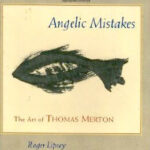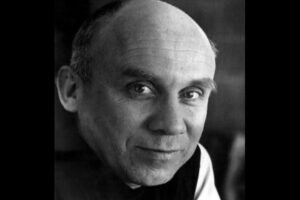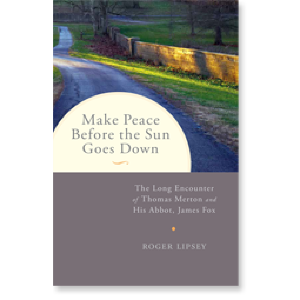By Dave O’Neal
We talk with Roger Lipsey about his book Make Peace Before the Sun Goes Down: The Long Encounter of Thomas Merton and His Abbot, James Fox
2018 will mark the fiftieth anniversary of the death of the most famous Trappist monk of modern times—or perhaps of all time—Thomas Merton. From his life of extreme silence and seclusion he became a pioneer in the religious dialogue between East and West, a force in the intellectual and political life of his era, and a beloved spiritual writer, whose influence has only increased in the years since his death. Roger Lipsey, a Merton scholar and author of a book analyzing a particular relationship from the last two decades of Merton’s life, took the time to have a conversation with us about the relationship portrayed in the book, and also about Merton and what he continues to mean for us today.
Dave O’Neal: Thomas Merton was certainly among the best known of Catholic writers of the last century, but Dom James Fox, the other subject of your book, is far less widely known. Who was he?
Roger Lipsey: Dom James (1896-1987) was abbot of Our Lady of Gethsemani in central Kentucky, the large monastery where Thomas Merton had been a member of the community since 1941. Elected abbot in 1948, Don James continued in that role until a year before Merton’s death in 1968. Born to a large working class family, Irish, in a Boston suburb, young James was a brilliant student who attended Harvard College on scholarship, graduated in three years, and spent another few semesters at Harvard Business School. His burning ambition at the time was to succeed in the business world, but there was something else in him, deeply religious, touched to the core by retreats he had made with the Passionist Fathers in the Boston area. Deciding to give his life to the Church and to monastic life, he became a Passionist but within a few years felt that its public teaching mission wasn’t a good fit. He needed greater solitude, a quieter life of prayer. Transferring to the Trappist Order—Gethsemani’s Order—he soon stood out as both a man of strong religious life and a gifted organizer. He came to Gethsemani as abbot when the community was failing financially. He turned that situation around within a few years. Gethsemani became his enterprise, and it began to thrive. It also attracted, in the late 1950s and early '60s, waves of vocations—predominantly young novices, at their greatest number a little more than 250, so many that a sort of tent city had to be set up for them in the “préau,” the once tranquil central garden at the heart of the monastic complex.
Why did so many hopeful men come to Gethsemani? In part, after World War II, many Catholic veterans had seen more than enough of “the world” and wanted something far different for themselves. But the strongest reason for their arrival at Gethsemani was Thomas Merton’s stunningly precocious, brilliantly written memoir of his own path to monastic life: The Seven Story Mountain.
Merton was a literary artist, a free and vastly creative spirit voluntarily subsumed to strict monastic discipline. Dom James was in many respects a nineteenth-century abbot, strict and traditional. They were destined to clash, seriously so, though they were also capable of cooperating on some issues of common interest, notably the education of the novices, for which Dom James made Merton responsible.
DO: How did you first become interested in Thomas Merton yourself?
RL: In 1982 I visited the Thomas Merton Center and Gethsemani for the first time, drawn by Merton’s abstract brush drawings and print. They were unstudied, even ignored—a few were used here and there as illustrations in new editions of his books. It took years more for me to turn toward writing Angelic Mistakes: The Art of Thomas Merton, for you, sir—for Shambhala. But by then my life had changed. I had joined Merton in the zone of convergence. It was no longer only his visual art that mattered to me; it was his entire realization of the life of search, of a spirituality that is sure enough of itself and of its direction to welcome uncertainty, to welcome others.
DO: The relationship between Merton and Dom James has long been known to be complicated, but you were able to chronicle the complications in a kind of detail that hadn’t happened before—did you have access to materials other scholars hadn’t yet seen?
RL: Yes, masses of archival material in two categories: already available but unstudied, and newly available through the kindness and trust of the current abbot of Gethsemani. Historians are archive people—archives are their joy because history or biography is strewn in archives, at best summarily ordered, probably unknown and in no particular order. You strive to assemble a coherent and true life story from, let’s say, debris left behind. You have to question the material, follow connections where they lead, let the story dissolve and re-form a number of times over as the material shows what it needs to be. The Merton archive at the Thomas Merton Center, Bellarmine University, Louisville, Kentucky, is a model of order—but so vast that much material in it remains to be studied and interpreted. The archives at the abbey itself, crucial to this book, were at the time of writing less well ordered but still entirely usable, deeply interesting.
DO: The book contains a very striking frontispiece illustration. Can you describe it, and say something about what it reveals about both Merton and Dom James?
RL: The frontispiece is an early page of a new Merton book (The Sign of Jonas, 1953) on which both Merton and Dom James wrote dedicatory words to a Trappist abbot in Canada, whom they both knew and obviously respected. The character of each man is evident on that page: Merton’s handwriting light and modest, expressing in French his “religious and filial homage in Our Lady,” Dom James’s handwriting expressing vigorously in English his “gratitude, affection, and assurance of our continual prayer.” But then there is something more from Dom James, a stamp he often added to his communications, just like the stamps we use for Air Mail or a return address. It reads: “All for Jesus, Thru Mary, with a Smile.” This was Dom James, a man of simple, direct, unintellectual faith. Within a few months of his abbacy, Merton had privately joked in his journal that he was going around the monastery with a smile.
DO: Merton was an unusual monk in many ways: a man vowed to the silent life who carried on an exhaustive correspondence with some of the great figures of his time; a hermit with an amazing number of friends. How unusual was he among Trappists of his era?
RL: Father Louis—as Merton was known across the Trappist world—was unique. There were writers and scholars in the Order; I’m thinking particularly of Fr. Chrysogonus Waddell (1930–2008), a widely respected musicologist and composer to whom Gethsemani owes many of its utterly beautiful “psalm tone” chants that are heard there daily. But there was no second Merton. His brilliant witness to the life of prayer, of intelligent sacrifice, of life as a Way that grips us but also raises us, remains for all to read, a source of inspiration. My book offers a fair amount of comment on where to look for Merton at his best in his autobiographical memoirs, his journal, correspondence (remarkable!), essays, and more.
DO: Can you give some idea of the breadth of Merton’s interests—in the social, religious, artistic, theological, or literary realms—during the period covered in the book?
RL: Oh my . . . He belonged to so many different worlds, contributed to so many different worlds. He was remarkable, and prescient, on the future of monasticism. He was a Western pioneer, recognized and befriended by D.T. Suzuki on Zen and its commonalities with Christianity. He was a fast friend of the Berrigan brothers, particularly of Dan Berrigan, in the anti-war movement of the 1960s, and he was regarded by the Berrigans and others in the movement as their spiritual counsel, their rudder in rough seas. He had a strong and searching prayer life structured initially around the insights of St. John of the Cross, the sixteenth-century mystic and monastic, and later a prayer and contemplative life that owed much to Zen. “How I pray is breathe,” he once wrote in the mid-1960s. And then, he explored the hermit life, argued for it from ancient Trappist lives and texts, and eventually lived it in his famous hermitage in the woods at Gethsemani. And then, and then. . . There is really so much. I should mention that in the early to mid 60s he explored abstract art through brush drawings and prints. Shambhala published my study of that aspect of Merton’s creative work: Angelic Mistakes: The Art of Thomas Merton. I’m happy to report here that Echo Point Books will soon republish that book.

DO: What was the Merton of the Dom James years (1950s and 60s) like—compared to the Merton so many have encountered in his best-selling memoir The Seven Story Mountain?
RL: You could say that there were three periods in Merton’s life and works. The Seven Storey Mountain, published in 1948 and a bestseller, crowned and completed the first period. Through those years he was somewhat ascetic, strongly, strongly Catholic, and a marvelously gifted witness to his own life in all of its breadth and emotions. In the mid-1950s, he responded willingly to pressure from Dom James and James’s superior in the Order in Europe to write much less and to adhere to properly Catholic topics intended for that community’s readers. Broadly speaking, the published works of that middle period are restrained; one hardly knows that Merton is their author. But his correspondence and private journal in those years remain immensely vital and searching. The third period, from about 1961 to his untimely death in 1968, is, so to speak, “my Merton,” and I hope yours. He is so interesting, so searching, so free of mind but religiously grounded, so centered in his poetic and interpretive abilities as an author. Wherever one looks—in essays, the journal, correspondence, elsewhere—he is a paradigmatic seeker, thinker, explorer of our shared reality and its innate spiritual dimensions.
DO: Can the relationship between Merton and Dom James be seen to symbolize something bigger than both men? Of course one can see the conflict between a Roman Catholicism that clung hard to tradition versus the openness that was happening in the wake of the Second Vatican Council, but is there a symbolism even greater, more “cosmic” than that?
RL: I think you’re right about this. The drama between them isn’t limited to “Catholics then,” or “the Church,” or any imaginable boundary. It is the drama of an immensely creative, searching—and, on occasion, undisciplined—spirit encountering limits set again and again by traditional, conservative attitudes and regulations. Merton’s path toward himself is a sign to us all.
DO: To what degree do you believe that Merton and Dom James were reconciled by the time of Merton’s death? Was there a sincere sort of healing that took place or was it more like “making nice” once they were no longer locked in a relationship of obedience?
RL: What to say here? They were both monks, both committed to the Cistercian way—and they knew that. That was a bond between them. On the other hand, Dom James’s endless restrictions on Merton were onerous, and Merton knew that, detested that. In all the years of Dom James’s abbacy, Merton was permitted to leave the monastery for more than one day on, I think, three occasions (apart from hospital stays). Yet he was justly in demand around the world. Dom James stood in the way.
DO: Do you believe Merton would have remained a monk all of his days, had his life not been cut so tragically short?
RL: As I write toward the end of my book, Merton had discussed with Trungpa Rinpoche, then young, in Delhi, the possibility of cofounding a monastery of a new kind, dedicated to meditation, profoundly inter-religious, and profoundly serious. Perhaps in the American southwest. I believe he would have moved toward that. Would he have remained a Cistercian monk and priest? I must say, I hope so: it suited him, it was a perfect identity for this man of immense good will and sensibility.
DO: How would you characterize Merton’s legacy, from the perspective now of half a century after his death?
RL: I don’t feel that it matters so much anymore whether one is Catholic, Protestant, Jewish, Buddhist, Muslim—and so on. What matters now is how one goes about it, how deeply it is felt, how one acts in relation to it, what inner identity it helps one to nurture and realize over time. There is a convergence, as one of my closest friends puts it, and in that zone of convergence it’s not labels and dogmas that matter, and it’s certainly not passionate advocacy. It is quality: quality of being, quality of action toward others, quality of wisdom and common sense intertwined. Merton already occupied that zone of convergence in his later years. In effect, he waits for us there.
Make Peace before the Sun Goes Down
$22.95 - Paperback



